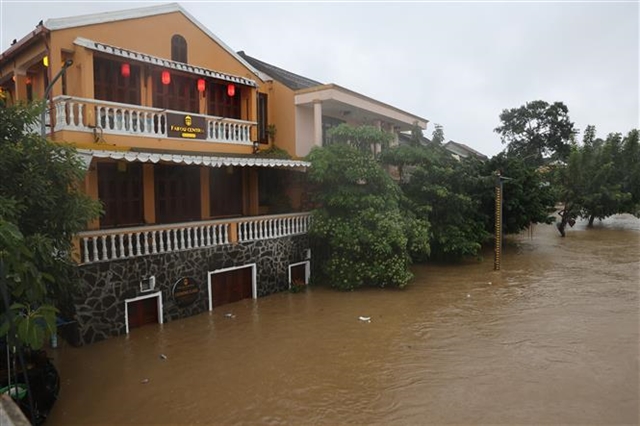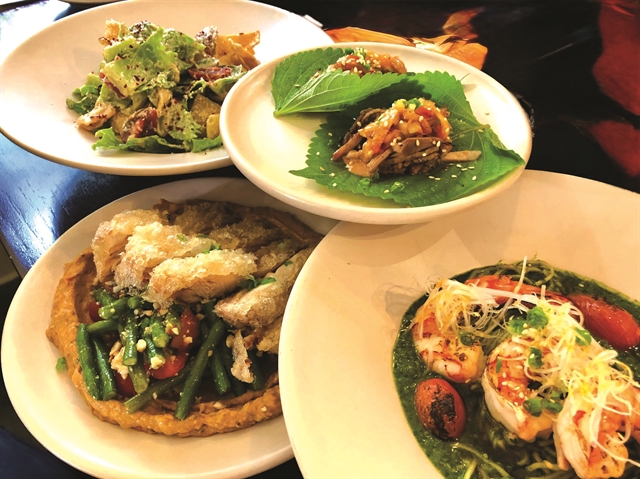 Restaurant Review
Restaurant Review

Sweet, savoury and steaming hot are just some of the features of Ha Noi’s most esteemed
bowls of pho. Hà Nguyễn learns that the broth is what makes or breaks a dish.
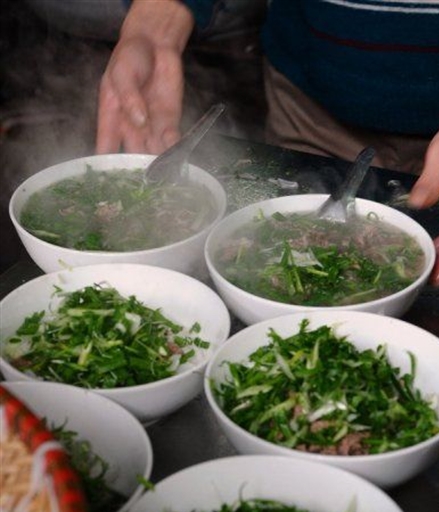 |
| Steaming bowls: CNN has named Hà Nội’s phở as one of the top ten most delicious dishes in the world. |
Sweet, savoury and steaming hot are just some of the features of Ha Noi’s most esteemed
bowls of pho. Hà Nguyễn learns that the broth is what makes or breaks a dish.
My friend Dương Quang Phong from Los Angeles arrived in Hà Nội for a trans-Việt Nam tour. He asked me to join him for phở, the most famous food inside and outside of the country.
We decided to start our breakfast at 49 Bát Đàn, a bustling street in Hà Nội’s Old Quarter.
As soon as we entered the street, we smelled the aromatic fragrance of phở from the shop, rousing our appetites. Although many years had passed by, the shop maintained its same shape, doors, old tables and tools - particularly a long queue of diners patiently waiting for their turn, said Phong.
We joined the queue and heard curt words from the shop owner, Trịnh Văn Hiếu, loudly asking guests about their orders and whether they wanted more or less rice noodles, or thick or light broth.
There was the familiar sound of a knife regularly chopping meat against a cutting board. Steam from big bowls of phở spiraled upward.
When our turns came, I ordered phở tái bắp lăn (stir-fried beef muscle), while Phong ordered tái lăn (half done stir-fried beef).
The shop owner skillfully cut the beef and put it into a bowl with sliced fresh onions before scooping broth on top.
The shop is so crowded that we had to struggle to find a seat before joining the queue. After receiving our dishes, we returned to our seats in a corner of the shop.
Phong said the quality of the broth has remained the same for 20 years, when he returned to Hà Nội the first time.
Whether phở is tasty or not depends on the broth and rice noodle, and here, the combination was just right.
Hiếu said he made the broth by simmering beef bone and organic spices such as ginger, cinnamon and sá sùng (sand worms) from the northwestern province of Yên Bái and the port city of Hải Phòng.
“My rice noodle is made from the VN10 species of rice grown in the northern provinces of Thái Bình and Nam Định,” Hiếu said. “The rice yields more powder, which makes our rice noodles whiter, softer and thinner, and helps it remain firm when it is dipped into hot water, compared with others.”
We enjoyed the phở very much, although each bowl was rather expensive at VNĐ 50,000-70,000.
Despite this, locals and foreigners continued patiently queuing for their turn to enjoy an aromatic and tasty phở.
Phong told me that he would like to enjoy more phở at other famous shops such as Phở Thìn at 13 Lò Đúc Street and Phở at 10 Lý Quốc Sư Street.
The next day we arrived at Phở Thìn early in the morning.
We asked for two bowls of tái lăn for VNĐ50,000 each. We did not have to wait long because there were not so many diners compared with Bát Đàn.
A server brought us two big bowls of phở, which was also full of rice noodles and stir-fried beef that was very fragrant. Although the servers were not so friendly, the service was quick and the quality of the food made us pleased.
The dish is fragrant and tasty because of the broth, which is greasy and quite sweet, while the tái lăn is soft and sweet, too, mixed with ginger and garlic.
This helps shop owner Nguyễn Trọng Thìn keep his trademark, which spread far and wide so that customers would never forget it.
Thìn set up his shop nearly 40 years ago.
From the onset, he tried phở at many other famous shops in the city and thought of special spices to create a unique recipe of his own.
After a year, he decided to serve phở tái lăn, in which the beef is quickly stir-fried over a big fire in a large pan with fat in it. After that, the thin beef pieces are put into the pan and stirred quickly. Ginger and garlic are added to the pan before it is scooped into the bowl.
In 2009, after 30 years of business, Thìn was invited to Seoul to teach phở cooking techniques to a number of Koreans and Vietnamese working and living in South Korea who wished to open a phở shop there.
“In Seoul, I made rice noodles, and chose beef and spices to cook more than 100 bowls of phở,” Thìn said. “The food was so well loved that all the bowls were left empty.”
A Korean general director of a large company told him he had never eaten such delicious food. He asked Thìn to sell his secret for making phở. Thìn agreed.
After three months of training, several phở restaurants opened in Seoul, including Tặng Restaurant, a popular place for Vietnamese and foreigners alike to come and enjoy "phở Thìn".
The next day, we tasted phở at 10 Lý Quốc Sư Street. When we reached the shop, a crowd of locals and foreigners had already gathered.
With prices between VNĐ40,000 and 50,000 per bowl, Phong said he could eat two bowls because the rice noodles seemed to be in smaller quantity compared with the other two shops, but the beef and broth were both excellent.
CNN has named Hà Nội’s phở as one of the top ten most delicious dishes in the world. -- VNS
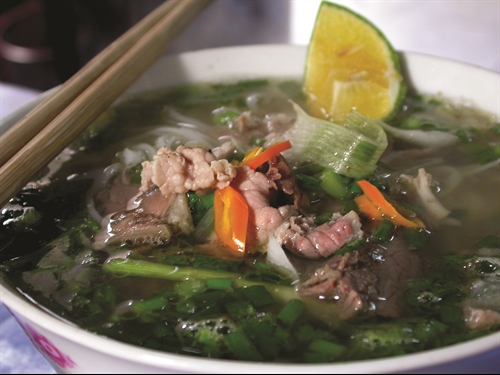 |
| Colourful: The broth at Phở Thìn is greasy and sweet, while the tái lăn is tender, mixed with ginger and garlic. VNS Photos Đoàn Tùng |
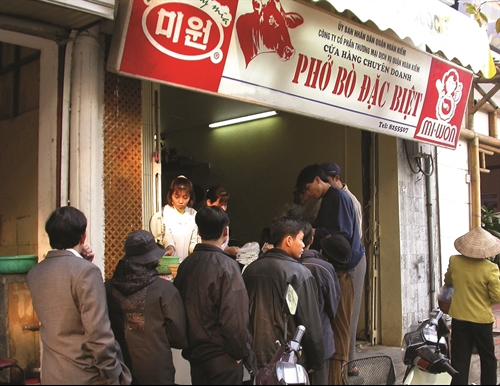 |
| Get in line: The phở at 10 Lý Quốc Sư Street always draws a crowd. |




